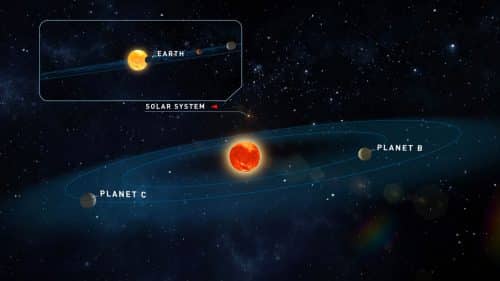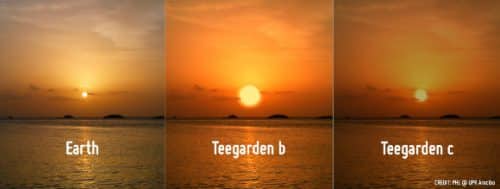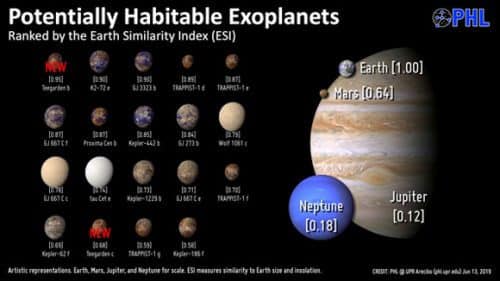Both are very close to their star: one completes its orbit in only 4.9 Earth days, and the other in 11.4 Earth days. However, since it is a star whose radiation intensity is less than a thousandth that of our sun, the two planets are in what is known as the "seated range" (or the area of life)

Since the first discovery of a planet in another solar system, in 1995, scientists have already discovered thousands of such planets. The first planets discovered are very large and very close to their sun, so they are far too hot to support life as we know it. The reason that such planets were discovered initially is a limitation of the research means - these are the planets that are the easiest to discover.
The planets in other solar systems cannot usually be seen directly, and indirect methods are needed to detect their existence. In recent years, scientists have been looking for more and more planets similar to Earth in size, composition and temperature on their surface, with the aim of locating life similar to ours somewhere. These efforts are gradually bearing fruit, with the improvement of measurement methods, and now an international research team reports the discovery of two Earth-like planets in a solar system relatively close to us.
Gemini promises
One of the promising research directions in the search for "earth twins" is their search around small "red dwarf" type windows. About three years ago, evidence was discovered for the existence of an Earth-like planet orbiting the sun closest to us, Proxima Centauri, and soon after, signs of such a planet were found around the red dwarf Ross 128, which is also not far from us, in cosmic terms.
To focus on red dwarfs, the CARMENES survey was launched three years ago: Calar Alto high-Resolution search for M dwarfs with Exoearths with Near-infrared and optical Échelle Spectrographs red dwarfs using visible and infrared spectroscopy). In fact, this is a device installed in an observatory in southeastern Spain, not far from Granada, and allows the radial velocity (that is, along the line of sight) of stars to be measured with great precision. When a planet orbits its sun, it pulls it slightly toward it. We cannot see the planets, because they are too small and their starlight hides them, but if we observe from a suitable angle, the star will appear to us as if it is moving away from us and approaching us alternately. These fluctuations can be measured through the change in the star's light: when it moves away, its light tends more towards the red in the spectrum, and when it gets closer, the light tends to blue, thanks to the phenomenon known as the Doppler effect, which causes a change in the frequency of the radiation according to the relative speed between the object and the observer. This effect is evident in any type of wave, and it can also be measured in infrared radiation, which is the main radiation emitted by such stars. The advantage of the CARMENES instrument is making measurements in both infrared and visible light and weighting between them, which increases the chance of finding signs of planets especially around red dwarfs.

The scientists conducting the survey mapped the red dwarfs in the relatively close vicinity of our solar system, up to 15 light years, and selected slightly more than 300 stars to focus on in the search for planets. About six months ago they identified a relatively small planet orbiting the red dwarf star Barnard, but it is much larger than Earth, and relatively far from its sun. Now they report the discovery of two planets much more similar to Earth around the Teegarden red dwarf, one of the 40 or so stars closest to our Sun, about 12.5 light-years away.
The team of researchers, led by Matthias Zechmeister from the University of Göttingen, reports that the planets may be only 1.1 times as heavy as Earth, but they appear to be slightly heavier: the best likelihood is that one of them has a mass of 1.25 Earths, and the other - 1.33 . At this size, there is a very high probability that they are rocky planets, like Earth, and not composed of gas. Both are very close to their star: one completes its orbit in only 4.9 Earth days, and the other in 11.4 Earth days. However, since it is a star whose radiation intensity is less than one-thousandth that of our Sun, both planets are in what is known as the "stable range" - a temperature range that allows liquid water to exist on their surface. If there is indeed water on them, or other conditions for sustaining life - this is a question that researchers still do not know how to answer. However, they are encouraged that these two planets are among the most similar to Earth yet discovered in other solar systems.

Great potential
The large research team also includes two researchers from Israel: Dr. Lev Tal-Or from Tel Aviv University, who contributed greatly to the improvement of the calibration of the complex measurements and the adjustment of the complex software that processes the observation data, and Dr. Aviv Ofir from the Weizmann Institute of Science, who is responsible for additional observations of the star itself, With the help of a global network of telescopes, to make sure that the slight deviations in its movements do indicate the presence of planets and rule out the possibility that they are caused by another feature of it. "The discovery provides us with more Earth-like planets, the ones around a star very close to us, so there is a lot of potential for further research that will focus on them," Ofir explained in a conversation with the Davidson Institute website. "Because this star is so close to us, it is very possible that the next generation of optical telescopes will be able to separate it from the planets, which will allow us to get a lot of information about them, for example trying to determine if they have an atmosphere and what their composition is. There is also a good probability that there are other planets in the system that we have not yet discovered."
Another finding that encourages the scientists who hope to one day discover signs of life on these planets is the estimated age of the Teegarden system - about eight billion years. Our solar system is about 4.5 billion years old, and researchers estimate that a system that is almost twice as old has had a long time to stabilize and develop life, if the conditions there are indeed suitable for it.
If there are indeed intelligent beings on these planets, and if they use methods similar to ours to search for planets in other solar systems, we may have good news for them: in 24 years their system will be located in a suitable plane to detect the Earth by the method by which we discovered most of the planets So far - measuring the cyclical decrease in sunlight as they pass between her and us. Over the years they will be able to identify more planets of our sun. If they haven't discovered this method yet - there is time. Their system will be at the right angle by the year 2496, and one can only hope that then there will still be life left on Earth.
A video by the University of Göttingen with a visualization of the Teegarden system and the planets discovered in it
for the scientific article
More of the topic in Hayadan:

5 תגובות
The logic that is based on the theory that says that intelligent life like ours must exist on the Indian border because of the astronomical mass of the planets is wrong!!! My reasoning is not based on a hypothesis but on the theory of randomness....
If the life on the two planets are friends with each other then we have a chance to be friends with them hahahaha it's just not humans killing each other what do you think will happen?
There was no life and there will be no life, because there is no life.
to an anonymous user
On the other hand, most of the planets discovered around red dwarfs are very close in their orbits to the red dwarf (circumference durations are measured in hours/days), it is probably a muffin of stars of this type, so the chances are that if planets are found around a red dwarf, the chances are that they will indeed be within the habitable zone. It has actually been published that red dwarfs are the best candidates for discovering Earth-like planets in the habitable zone and for other reasons as well.
The researchers looked for life zones around red dwarfs, stars that are 50-90 percent smaller than the Sun and much colder. This population makes up 70% of the stars in the Milky Way, but is more difficult to detect due to their fainter light. They were surprised to find that these red dwarfs also have a habitable zone, but its size is tiny. When they added up the volume of the habitable zones of 44 red dwarfs close to us, the total combined did not equal that of a single star such as our Sun. So despite their explosiveness, they are not good candidates for detecting life. Earth-like planets would need to be located in the exact spot in the tiny habitable zone for them to be good candidates for life.